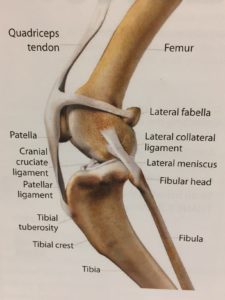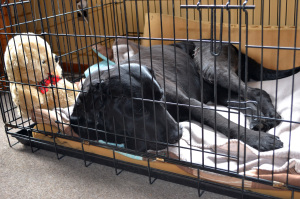Thursday, August 2nd, 2018
Cruciate Ligament Injuries
The cruciate ligaments are in the knee and act to stop the femur ( top leg bone ) and tibia (lower leg bone ) from sliding excessively forwards and backwards. The cranial cruciate ligament and the caudal cruciate ligament cross over each other at ninety degrees creating a cross, hence the name. The cranial cruciate ligament is often damaged by sudden jarring of the back leg by jumping or by wear and tear.
Because of the way that some dogs are built, they are prone to cruciate disease and their ‘ good leg ‘ may also develop cruciate ligament damage at a later stage, especially if it takes the damaged kness a while to repair and they rely on their ‘ good leg ‘ to weight bear for an extended period.
When this ligament tears, it is very painful and when it ruptures completely it can no longer prevent excessive movement in the joint. Dogs typically present with ‘ toe touching ‘as if their foot is sore, as bearing weight causes them to feel the pain in their knee. Some animals also damage their meniscus, a cartilage pad that provides cushioning between the femur and tibia , which is also very painful.
The simplest surgery option is the placement of a Nylon suture which is aligned to prevent instability in the stifle and to stop excessive movement while healing takes place. Providing that the strict post – operative rest is taken with no exercise for the first few weeks to ensure minimal risk of the nylon breaking, the rate of success is high.
Other surgical options involve more invasive surgery with the placement of special plates to realign the knee joint and they allow for quicker return to function of the leg without the risk of breaking the artificial nylon ligament used in the simple procedure.
After surgery, rest for 4-12 weeks is important to ensure a successful outcome. During rehab a gradual return to exercise is imperative and physiotherapy and hydrotherapy are useful tools to assist recovery.
Providing optimal nutrition with wholesome food and avoiding excessive carbs as well as chemicals and preservatives helps to support the body’s healing process. Optimal amounts of nutrients such as omega 3 fatty acids, anti-oxidants, vitamin c and glucosamine as well as herbs such as turmeric are helpful too. Weight management is very important and feeding lower amounts to dogs that are inactive so that they don’t gain weight is imperitive.
With the right strategy , most animals heal beautifully and even though it can be a long haul to recovery, investing the time and effort to support optimal healing is well worth it in the long run.


